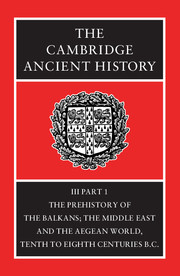Book contents
- Frontmatter
- PART I THE PREHISTORY OF THE BALKANS TO 1000 B.C.
- PART II THE MIDDLE EAST
- PART III THE BALKANS AND THE AEGEAN
- 14 The Early Iron Age in the Central Balkan Area, c. 1000–750 B.C.
- 15 Illyris, Epirus and Macedonia in the Early Iron Age
- 16 Central Greece and Thessaly
- 17 The Peloponnese
- 18a East Greece
- 18b The Islands
- 19 The Geometric Culture of Greece
- 20a The Earliest Alphabetic Writing
- 20b Greek Alphabetic Writing
- 20c Linguistic Problems of the Balkan Area in Late Prehistoric and Early Classical Periods
- 20d The Greek Language and the Historical Dialects
- 20e Balkan Languages (Illyrian, Thracian and Daco-Moesian)
- BIBLIOGRAPHY
- Index
- Map 1. The Palaeolithic and Epipalaeolithic (Mesolithic) periods in Romania
- Map 2. The Neo-Eneolithic period in Romania
- Map 3. The period of transition to the Bronze Age in Romania
- Map 4. The Bronze Age and Hallstatt A period in Romania
- Map 5. Gold and bronze hoards in Romania
- Map 13. Urartu">
- Map 17. Egypt
- References
14 - The Early Iron Age in the Central Balkan Area, c. 1000–750 B.C.
from PART III - THE BALKANS AND THE AEGEAN
Published online by Cambridge University Press: 28 March 2008
- Frontmatter
- PART I THE PREHISTORY OF THE BALKANS TO 1000 B.C.
- PART II THE MIDDLE EAST
- PART III THE BALKANS AND THE AEGEAN
- 14 The Early Iron Age in the Central Balkan Area, c. 1000–750 B.C.
- 15 Illyris, Epirus and Macedonia in the Early Iron Age
- 16 Central Greece and Thessaly
- 17 The Peloponnese
- 18a East Greece
- 18b The Islands
- 19 The Geometric Culture of Greece
- 20a The Earliest Alphabetic Writing
- 20b Greek Alphabetic Writing
- 20c Linguistic Problems of the Balkan Area in Late Prehistoric and Early Classical Periods
- 20d The Greek Language and the Historical Dialects
- 20e Balkan Languages (Illyrian, Thracian and Daco-Moesian)
- BIBLIOGRAPHY
- Index
- Map 1. The Palaeolithic and Epipalaeolithic (Mesolithic) periods in Romania
- Map 2. The Neo-Eneolithic period in Romania
- Map 3. The period of transition to the Bronze Age in Romania
- Map 4. The Bronze Age and Hallstatt A period in Romania
- Map 5. Gold and bronze hoards in Romania
- Map 13. Urartu">
- Map 17. Egypt
- References
Summary
INTRODUCTION: GENERAL CONSIDERATIONS
This chapter, being a direct continuation of chapter 4, deals with events in the Balkan Peninsula down to c. 700 B.C. Although the year 1000 B.C. was adopted in CAH 11.2 as a dividing line in general, there are specific reasons for starting our account at a date in the region of 1200 B.C. In the first place, the period c. 1200–700 B.C. may be regarded as a closed unit in the interior of the Balkan Peninsula, in the hinterland of the Aegean littoral and in the eastern Mediterranean in a wider sense. During that time there was an uninterrupted and unique cultural development, which can be traced despite regional differences and individual stages. In the second place a significant turning-point in the historical process occurred early in this period. It was marked by the so-called Dark Age in Greece, the invasion of the ‘Sea Peoples’ in Egypt, the destruction of the Mycenaean towns in Greece, and the fall of the Hittite Empire in Asia Minor. Finally, it was the period of the Trojan war and the settlement of the Philistines in Palestine.
Recently many historians and archaeologists have treated the problems of the migrations of this period, especially the Dorian invasion, in a more critical and cautious manner. They have regarded the invasion of the Sea Peoples in Egypt more as incursions by individual groups bent on pillage than as migrations by large numbers of people. Similarly in dealing with the destruction of the Mycenaean towns and the empire of the Hittites they have paid more attention to the presence of internal strains and possible antagonisms within those societies.
- Type
- Chapter
- Information
- The Cambridge Ancient History , pp. 582 - 618Publisher: Cambridge University PressPrint publication year: 1982
References
- 1
- Cited by

